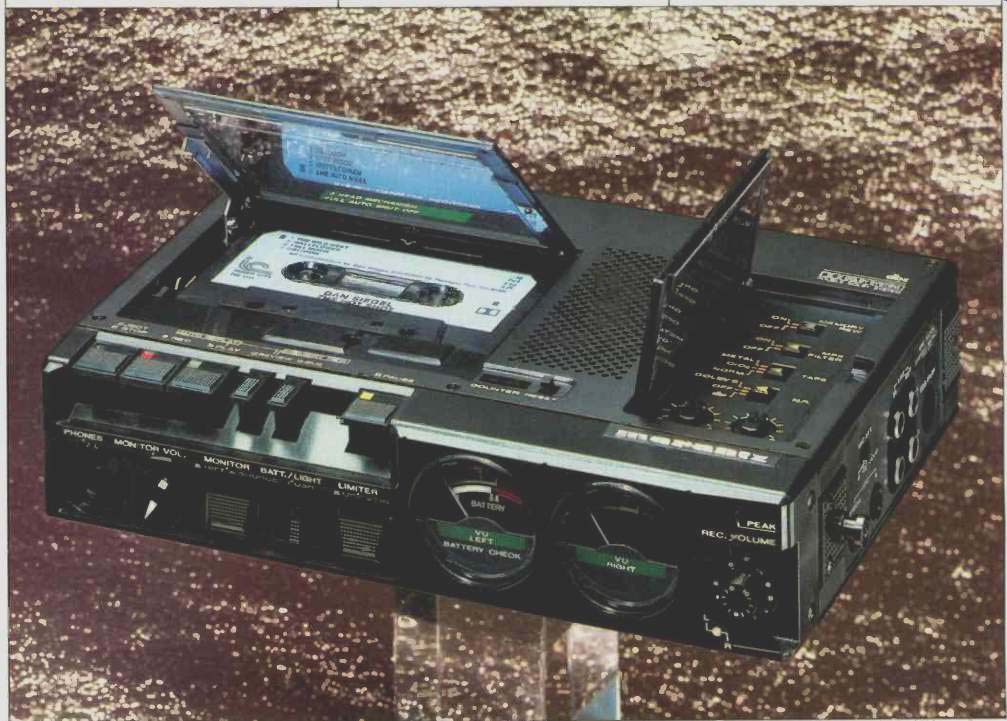
Manufacturer's Specifications
Frequency Response: 35 Hz to 14 kHz, to 15 kHz with CrO2 tape. and to 17 kHz with metal tape.
Signal/Noise Ratio: 50 dB; 60 dB with Dolby B NR and 75 dB with dbx NR.
Input Sensitivity: Microphone. 0.2 mV: line, 70 mV.
Output Level: Line, 500 mV.
Flutter: 0.1% wtd. rms.
Battery Life: Playback time, 7 1/2 hours: recording time with metal tape, 5 1/2 hours.
Dimensions: 9 in. W x 2 in. H x 6 1/8, in. D (227 mm x 50 mm x 165 mm).
Weight: 3 lbs. (1.3 kg).
Price: $499.95.
Company Address: 20525 Nordhoft St., Chatsworth, Cal. 91311.
The PMD430 is the top-of-the-line addition to Marantz's PMD series of portable cassette recorders. For those familiar with the earlier units, such as the PMD360, this new recorder will seem marvelously compact considering its features and performance.
Using portable recorders in remote locations of any sort requires different techniques, and there are definite benefits from features that are not as essential in a home-bound deck. Recording a live concert, for example, where there is no chance to start over with reduced record levels, would be greatly aided by the three-head configuration of the PMD430. The deck also includes a limiter to ensure against unexpected level increases that might cause distortion. The recorder offers both Dolby B and dbx NR, and can use the three major tape types (I, II, and IV). Marantz also includes playback pitch control and adjustable bias.
There are left and right microphone inputs with flexible switching, as well as the normal line inputs. A microphone attenuator, which facilitates recording high-level sound with out input overloading, is a valuable feature. The single, built in loudspeaker can be switched for monitoring either the left only, the right only, or a mix of left and right.
The PMD430 can be powered by batteries, of course, either three alkaline D cells or the optional RB430 recharge able battery pack. Operation on a.c. is possible with the supplied accessory adaptor, which will also recharge the battery pack.
Control Layout
The transport switches, the piano-key type, are along the left front edge of the PMD430's top panel. From left to right, they are "Stop/Eject," "Rec," "Play," "Review," "Cue," and "Pause." "Rec," "Play," and "Pause" keys are color-coded with small squares-red, green, and yellow, respectively.
"Review" and "Cue" are narrower than the other keys, and separated from them, which facilitates general use and also offers tactile clues to aid mistake-free operation. "Review" and "Cue," of course, refer to use with play mode where a partial depression of the key gets fast winding with audible clues and release results in a return to play. In normal use, full depression obtains latching for regular fast forward or rewind, and the output is muted. If rewind is latched down when the memory switch is on, the tape will wind to about "000" on the counter; if this is done with the recorder in play mode, play will resume automatically at that point. Memory works similarly with fast forward, but the unit I tested stopped at "900" in this mode.
One push of "Stop/Eject" stops the transport; a second push releases the spring-loaded cassette-compartment door and pops the front edge of the tape up out of the well. Removing a cassette is really quite easy, but there is no carrier so loading does require attention to ensure proper seating. The unit can be put into play mode without a cassette in place; this yields good access to the heads and pinch roller for demagnetization or cleaning. To the right of the well is the single loudspeaker and, in front of the speaker, the counter and its reset button.
Further to the right is a rectangular. inset panel with a hinged, clear-plastic cover. Mounted in the panel are four slide switches and two trimpots. From back to front, the switches are "Memory Rew" ("On/Off"), "MPX Filter" ("On/ Off"), "Tape" ("Metal/CrO2/Norm.") and "N.R." ("Dolby B/ Off/dbx"). Each of the switch buttons has a small green arrow which points exactly to little red indices for each of the switch positions. The side-by-side trimpots have bar-type knobs and center-of-rotation detents. The one on the left is for pitch control in playback; it is defeated in record mode. The right-hand pot, for bias trim, allows matching a wide range of tape formulations.
On the front panel, under the transport switches, are (from left to right) the stereo headphone jack, the monitor volume control, the monitor switch ("Tape/Source"), the momentary-contact "Batt./Light" switch, and the limiter switch. The bar-shaped volume knob is easy to turn, and its white arrow conveys its position without any confusion. The monitor and limiter switches latch in for their "Source" and "On" positions, respectively. The travel is not great and the buttons are all black, however, so care is needed to be certain of what has been selected. A push of "Batt./Light" when the recorder is in any operating mode will turn on lights of both meters. While the button is held in, the left meter will indicate battery voltage on a special scale. The meter lights stay or for 10 S after release of the button. This is a reasonable simple and effective solution to the problem of meter illumination and battery checking, particularly important in mote recording. (I trust that most readers understand leaving meter lights on all of the time when operating batteries would reduce battery life considerably.) The VU-type meters have limited markings ("-- 4/0/ + 3/ + 5") and a total length of just 3/4 inch. Thrare yellow up to "0" and red from "0" to " + 5." The t also has red and white battery-status scales, w indicating the minimum acceptable voltage for all teries and "R" showing the minimum for the re--1 battery pack. The white meter needles show up k background, but the scale markings are too small reading sight of the meters are dual-concentric, friction r.pc Volume" pots. The friction is on the high side 411 knobs, and it was difficult to get adequate smooth adjustment of relative levels. I did verb shaped, red LED volume indicator which " record mode; the small LED peak indicator is d.c r, just above the pots., side panel of the PMD430 are the 4.5-V d two slide switches. One switch turns the speaker off, while the other selects whether the speaker will monitor the right or left channel or both together. Since there is just the single speaker, it is not possible to have an audible stereo output, but the switching allows comparisons. Switch designations are all molded into the black plastic, which requires good lighting for good legibility.
On the right-hand side panel are the expected line in/out stereo pairs as well as a "Rec/Play" DIN-type socket. The facilities for microphones are more extensive and more flexible than those found on the great majority of recorders. The left and right phone-jack inputs are single-ended, but the left input will accept a stereo microphone with a tip-ring-sleeve plug. This is a nice and uncommon feature. I also applaud the provision of a microphone attenuator ("0/-15/-30 dB"). which can be essential in preventing input over load with high-level sources (read: pop/rock). There is also a stereo/mono "Mic Mode" switch; in its mono setting, the signal from a single microphone connected to the left input will be fed to both channels.
The designations on the right side panel are white on a black background, as are those on the front and top of the PMD430. They are quite easy to read under most lighting conditions. When the recorder is placed in its leatherette carrying case, the right-side and transport switch designations are covered over, with a little loss in convenience. With the color coding of the transport controls, there is not much of a loss, and the case has the right-side labels imprinted a little light clarifies all. Rubber feet on the bottom of the recorder itself allow it to be placed safely on any surface without use of the case.
Pushing up on two thumb latches on the back of the PMD430 opens the battery compartment, which takes three D cells or the optional rechargeable battery pack. There is no access to this compartment when the unit is in the carrying case. However, if the battery pack is installed, it can be recharged with the case on, because the 4.5-V jack remains accessible.
The case has a cover over the front panel and the trans port controls; this can be unsnapped, pulled down and around, and snapped back flat under the bottom of the unit. The cover over the cassette compartment door has a snap (which must be undone, of course, to eject or load a tape). Steel lugs on each side of the recorder accept the ends of a carrying strap. The web strap can be snapped on and off very easily, but the retention method is quite safe. An accessory pouch is supplied with the unit, which can be used to carry spare cassettes, batteries, or perhaps small microphones. A snap loop allows the pouch to be hung on the carrying strap, if desired.
I took some of the covers off the unit and saw quite a bit of excellent soldering, but I could not examine more of the internal construction without doing unwanted disassembly. The PMD430 was quiet in record or play and also reason ably so when fast winding.
Measurements
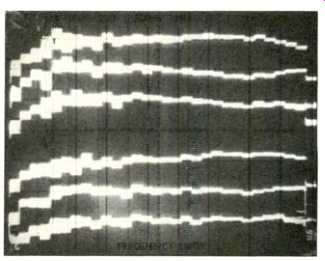
Fig. 1--Record/playback responses for three tapes, at two levels, using Dolby
B NR. From top to bottom: TDK AD (Type I), Memorex HBXII (Type II), and Fuji
FR Metal (Type IV), all at Dolby level; then the same three tapes at-20 dB.
(Vertical scale: 5 dB/div.)

Fig. 2--Same as Fig. 1 but using dbx NR.
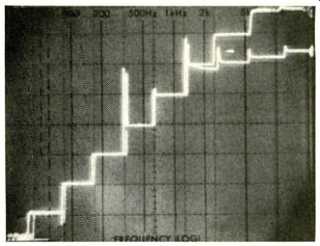
Fig. 3--Effects of sudden level increases with and without limiter. Input
level was increased 10 dB every 2 S up to 30 dB above meter zero. Note how
the limiter keeps the recorded signal level from rising above +4 dB. Spikes
shown were produced by the attenuator, not the tape 'ck. (Scales: Vertical,
dB/div.; horizontal, /div.)
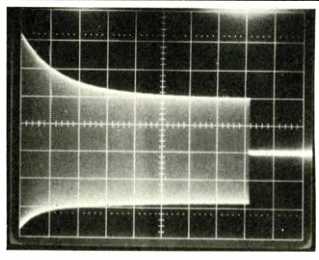
Fig. 4--Response of limiter to a 2-kHz, 160-mS tone burst 20 dB above the
limiter threshold; see text. (Horizontal scale: 20 mS/div.)
The playback equalization for Type I tapes fell within ± 1.0 dB over the whole audio range. The equalization for Types II and IV fell at the highest frequencies, but stayed within 2 dB of correct, and most points were within 1 dB. Tape play speed varied slightly, but the average was accurate, just 0.1% slow. Meter indications for a standard flux level (Dolby level, 200 nWb/m) were very close to exact, and the meters were calibrated to show Dolby level at " + 3." Record/playback responses were checked for a large number of tapes, using pink noise rolled off at 6 dB/octave above 2 kHz to make it more music-like. A mirror-image boost of the recorder playback restores a flat RTA display for flat response. For a first look, I tried to find tapes which best matched the recorder with its bias trimpot left at its center detent. Among Type I tapes, the best choices were BASF LH Extra I, Denon DX1, Memorex dB, PDMagnetics FERRO, Scotch CX, and Sony HF. Because these are all lower performance tapes. I went through higher ranked formulations and reset the trimpot for best results. I selected TDK AD for further testing but noted that excellent results were also obtained with Fuji FR-I, Maxell UR, and TDK AD-X.
The best responses for Type II tapes came with Memorex HBXII; Maxell UDS-II and Memorex HBII were slightly behind. Very good results were also obtained with Denon HD7, Fuji FR-II and GT-II, Memorex CDXII, Nakamichi SX and SXII, Sony UCX, and TDK HX-S, SA and SA-X.
Fuji FR Metal was the best Type IV tape for use with the PMD430, and Maxell MX, Sony Metal-ES, TDK MA and MA R, and Yamaha MR were not far behind. The bias could not be set low enough to match some of the older metal formulations, and it could be set just high enough for Sony Metal ES. There is no complaint from me, however, because so many decks have no bias trim for Type IV tapes.
Figure 1 shows the record/playback responses, using Dolby B NR, for TDK AD, Memorex HBII and Fuji FR Metal. There is evidence of some roll off at the low-frequency end and a sharp roll-off approaching 20 kHz. In general, the responses are very good, especially at-20 dB. Notice the excellent flatness from 63 Hz to 16 kHz. At the 0-dB level, the Type II and Type IV tapes show a similar high-frequency droop, and there is a slight roll-off with TDK AD. Table I lists the-3 dB points measured with a test tone. The high frequency limits at the higher level are not impressive, although that for Fuji FR Metal is reasonably good. The high-end limits at -20 dB are no match for those of many decks, but they are better than specification, and the flatness of the responses was obvious during these tests.
Figure 2 shows the record/playback responses, with dbx NR, for the same three tapes. These results are also very good, and note that the 0-dB responses with dbx NR are superior to those with Dolby B NR. Table II lists the results of miscellaneous tests run with both Dolby B and dbx NR. For Fuji FR Metal tape, the erasure at 100 Hz is quite good, 57 dB with Dolby B NR, and the broad-band expansion of the dbx decoder resulted in an outstanding figure of 88 dB. The excellent separation and crosstalk figures were also improved with dbx NR--in fact, the crosstalk was at least 99 dB down. There were variations in the 10-kHz phase relationships from trial to trial.
The jitter figure in Table II is for the worst case; it was usually better than the data shown. The multiplex filter's attenuation was the greatest that I can recall, and its notch was very accurately placed. Bias in the output during recording was very low.
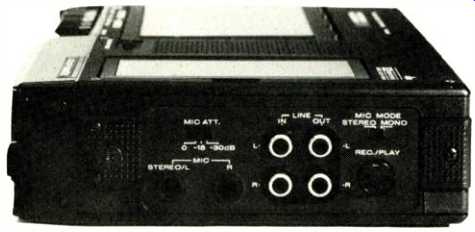
------------- Input and output jacks are grouped conveniently with the
versatile microphone-input switching facilities.
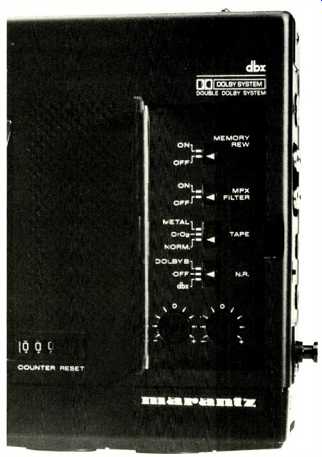
--------- A flip-up lid protects these controls from accidental resets.
The pots shown are for speed and bias trim.
The third-harmonic distortion level (HDL3) was measured for the three tapes, both with Dolby B and with dbx NR, from 10 dB below Dolby level to the point where HDL3 reached 3%. Table III shows that distortion was generally low and that the limit with dbx NR was well above the " + 5" meter scale maximum. For both TDK AD and Memorex HBXII, the distortion with dbx NR actually dropped as level rose from 10 to-8 dB. I did not pinpoint the exact cause of this anomaly, but it is possible that there was cancellation of out-of-phase electronic versus magnetic distortion components.
Table IV lists the figures for HDL3 from 50 Hz to 5 kHz at-10 dB with Fuji FR Metal tape, both with Dolby B and with dbx NR. The results are excellent over most of the band, and the very low figures for the higher frequencies are superior to those of most decks. There is the expected rise in distortion at the lowest frequencies; the figures with dbx NR are substantially the same as for non-portable decks.
Table V shows signal-to-noise ratios for the three tapes, with both IEC A and CCIR/ARM weightings, using Dolby B and dbx NR. The figures are excellent for Dolby B NR, but the dbx NR results may seem low in comparison with those for other decks. The fundamental cause of this discrepancy is that the PMD430's maximum output level is about + 10 dB, while a number of other, non-portable decks will reach about + 17 dB at the 3% distortion limit. I suspect that the lower figures for the Marantz unit go with the voltage and power limitations that must be applied to a portable unit to ensure adequate recording time on battery power. In any event, 80 dBA is really an excellent figure.
Various input and output characteristics at 1 kHz are presented in Table VI. Everything checked out just fine, as shown, with the exception of the line output: 311 mV at meter zero was below specification, although the output at Dolby level was the specified 500 mV-no problem, in any event. With the use of the microphone attenuator, the over load level was moved up to 76 mV (at "-15") and then to 360 mV (al "-30"). The attenuator .s an excellent feature to include, and I wish that more recorders with microphone inputs had them.
The dual-concentric input-level pots provided matching attenuation within 1 dB for a range of 50 dB down from maximum. The monitor pot for the speaker and/or headphones matched similarly over a range of 55 dB--excellent performance for both controls. All headphones I tried could be driven to a high level-very high levels with the sensitive phones. At a zero meter level and a maximum monitor volume setting, the speaker output at 1 foot was about 92 dB SPL, which should be plenty loud enough for normal monitoring. The line-output polarity was the same as the input in "Tape" mode, but it was reversed in "Source." The limiter produced a 2-dB reduction in level when switched on with a "+ 5" meter level, reducing the indication to " + 3." Figure 3 shows the action of the limiter with a test-tone input level of-60 dB (re: meter zero), increased 10 dB every 2 S. There are two runs shown in the display, first without the limiter and then with it operating. In the first run, there was a great deal of clipping at +20 dB, and at +30 dB the waveform was quite square. With the limiter switched in, the level was kept from increasing above about " + 4." (The attenuation-change spikes in Fig. 3 were caused by the attenuator I used.) Figure 4 shows the line output with a 2-kHz, 160-mS tone burst fed to the line input at 20 dB above the limiter thresh old. There was some clipping of the first part of the burst, and the handling of the burst was not symmetrical to zero level. I found that a good part of the total correction occurred within 20 mS.
The meter scale calibrations were within 0.2 dB from "-4" to " +5," but less accurate at "-10" (-11.2 dB actual) and "-20" (-24 dB actual). The meters are la belled "VU," but their response time (160 mS) was shorter than the standard (300 mS) and the decay (740 mS) was longer. The meters were 3 dB down at 14 Hz and 19.8 kHz.
The peak indicator turned on at " +2" with a 1-kHz test tone, and at " + 5" with a 5-kHz test tone. For a tone level 3 dB above threshold, the duration of a tone burst had to be at least 10 mS to get a noticeable flicker from the peak LED.
This is fairly good performance, but I would have preferred a lower threshold at 5 kHz and half the response time.
The average tape-play speed decreased by 0.03% with line voltage decreased from 120 to 110 V, and increased by the same amount with the voltage increased from 120 to 130 V. The instantaneous tape speed varied cyclically by about ± 0.04%, with a 1-S period, both on battery and line power.
The average tape speed was 0.1% higher with the unit tilted upward to rest on its back panel, or hanging from its strap, than when the recorder was placed flat on the test bench.
The average speed on batteries was 0.6% slower than on line power. I also noted changes in speed over a long period of time, with a rise of approximately 0.3% over an hour or two. A warm-up period appeared in order for the best speed stability when recording.
Flutter was consistent at 0.10% wtd. rms and 0.17% wtd. peak, both with battery and line power. There was very little effect on flutter or speed when I moved and rotated the PMD430. Only vigorous rotations on an axis parallel to the reel spindles caused measurable or audible effects. The fast-wind time for a C-60 cassette was 95 S, on the slow side compared to non-portable decks. The pitch control has a wider range than most, from-8.2% to + 9.7%, in contrast to the typical semi-tone range ( ± 5.9%).
Run-out times to stop were about 3 S, in either play or fast wind. With the mechanical interlocking of the controls, all mode changes require going through "Stop" except when going to "Cue" or "Review" from "Play."
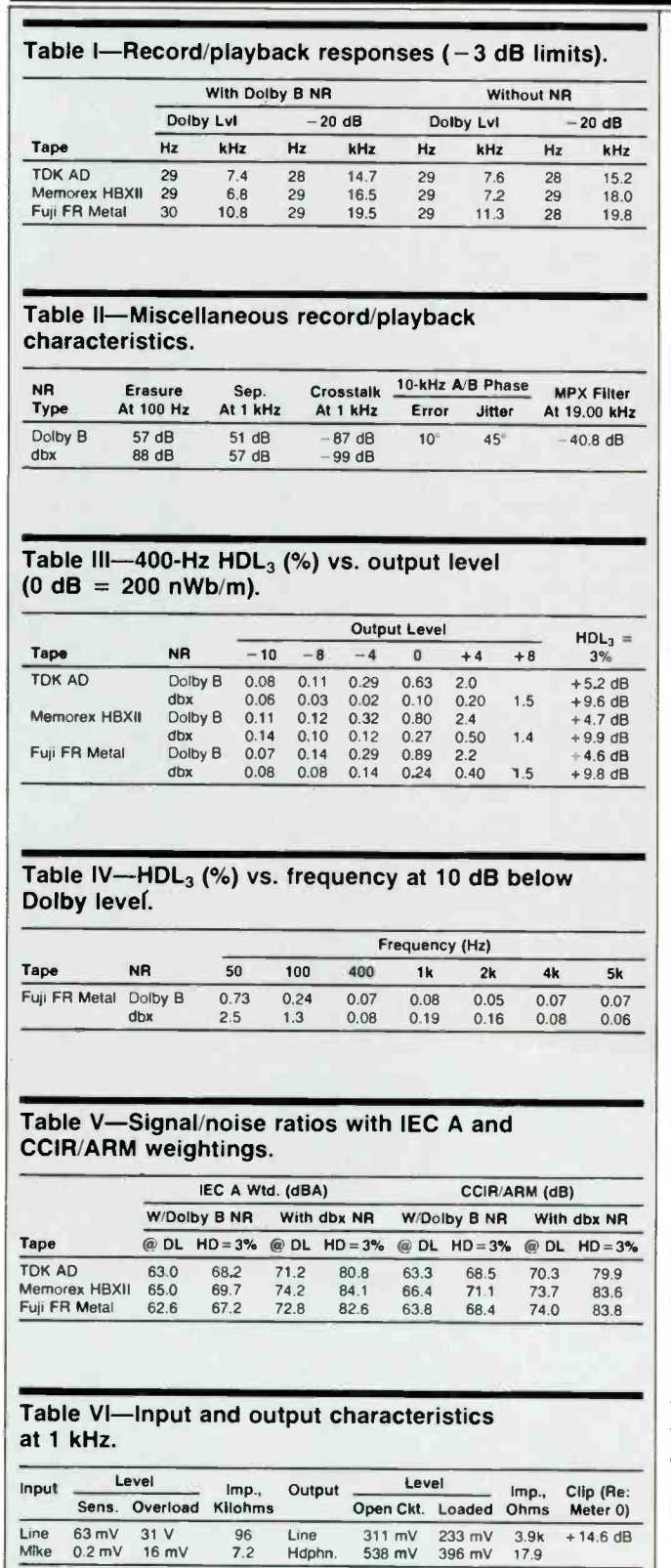
Table I--Record/playback responses (-3 dB limits).
Table II--Miscellaneous record/playback characteristics.
Table III--400-Hz HDL3 (%) vs. output level (0 dB = 200 nWb/m).
Table IV--HDL3 (%) vs. frequency at 10 dB below Dolby level.
Table V--Signal/noise ratios with IEC A and CCIR/ARM weightings.
Table VI--Input and output characteristics at 1 kHz.
Use and Listening Tests
The bilingual (English/French) owner's manual has good illustrations and generally good text, but there should have been better instructions on setting the limiter; turning up "Rec Volume" too high could cause input overloading at the same time that the meters continue to have an on-scale indication. There is very good information on the requirements for an external power supply, lacking in most manuals on portables.
All of the controls and switches were reliable and generally easy to see and use. The exceptions were the not-so legible in/out positions of the monitor and limiter switches, and the hard-to-adjust dual-concentric input-level pots. (I was getting better at making single-channel level changes by the end of the testing, but adjustment remained fussy.) Cassette loading was fussy too. but I learned that wiggling the cassette as I loaded it would seat it speedily.
In general, the meters were easy to work with, better than I thought they would be, but I still relied a lot on the peak indicator, and there were flashes at times when meter indications reached only "-10" or so. With Dolby B NR. double clicks could be heard when stopping and starting: with dbx NR, there was no start sound and a single click with stop. I heard no sounds for "Pause" with either of the noise-reduction systems.
Listening tests were run primarily with dbx-encoded versions of digitally recorded LPs, such as Danzas Fantasticas with the London Symphony Orchestra conducted by Morton Gould (Chalfont SDG-302/dbx PS-1028). I really enjoyed the playback of the dances by Falla and others with all three of the tapes, although the sound with Fuji FR Metal was definitely the most realistic, both with Dolby B and with dbx NR, and this was true with all LPs copied. There was an excess of bass with the other tapes, and with TDK AD the bass was muffled at higher levels. There was also obvious added presence with TDK AD, and there was better frequency balance with Memorex HBXII.
My listening tests confirmed an earlier conclusion: Unless dbx NR or the limiter was in use. flashes of the peak indicator had to be kept to a minimum to ensure really low-distortion recordings. Moving the recorder around during playback of a piano recording produced no observable effect on the sound, with line or battery power, unless the movement was quite sudden around a spindle-parallel axis or the unit was allowed to bang on the test bench.
The Marantz offers a collection of features which are most appropriate to the Kinds of use a portable gets: Three-head configuration, a limiter, and flexible microphone inputs including a three-step attenuator. Many aspects of its performance merit respect, especially the low distortion and the flat record/playback responses. The inclusion of both Dolby B and dbx NR systems is appealing, to say nothing of its true metal-tape compatibility and the bias trim that is effective on all tape types. There are some minor speed changes with time, and the flutter might be detected by a critical ear on a sensitive recording. Loading a tape into the well and adjusting channel volumes were a bit difficult too. Overall, however, the Marantz PMD430 offers a neat package of fun, convenience and performance for its cost.
-Howard A. Roberson
(adapted from Audio magazine, Jul. 1986)
Also see:
Marantz PM-94 Integrated Amplifier (Equip. Profile, Dec. 1988)
Marantz 1120 Integrated Amplifier (May. 1973)
Marantz Model 7 Preamp & Model 9 Mono Amp (June 1997)
Marantz Model 2500 Stereo FM/AM Receiver (Feb. 1978)
= = = =